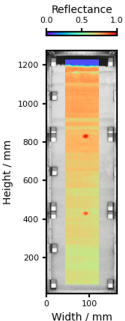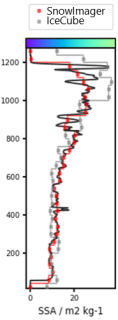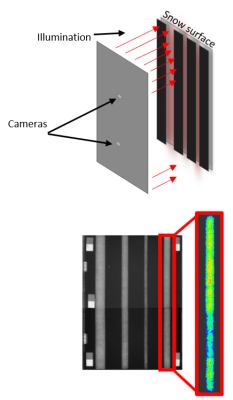Data Products
The reflectance images captured with the SnowImager allow to derive specific surface area (SSA), density and liquid water content (under development) using specific post processing algorithms and calibrations. Typically several reflectance images are stitched together to form a larger image.
Specific Surface Area (SSA)
SSA is derived by applying by applying an exponential calibration function to the reflectance image (940nm) to the reflectance image (wavelength?) captured with the SnowImager. SSA maps are two dimensional and spacial features can be visualised. The figures below show the workflow from a reflectance image to a SSA map and a vertical SSA profile. The right most figure shows the SSA profile in comparison to the results of the IceCube instrument. The black line is the full resolution of the snow imager, while the red line is downsampled to the IceCube resolution.

NIR reflectance profile of a snow stratigraphy measured with the SnowImager


SSA calibrated SnowImager profile


Horizontally averaged SSA values compared to the SSA values determined with the IceCube instrument.
Density
A mountable grid plate allows to image vertical slits that are needed to extract a density profile. The grid plate consists of vertical slits of different with (10 -30 mm). From reflectance in the slit, the local density can be derived. The reflectance drops towards the slit edge depending on the density of the snow. This is a new method that has been developed in conjunction with the snow imager (patent pending).

Liquid Water Content (LWC)
The potential to derive liquid water content is currently explored. As the relation between liquid water content and reflectivity depends on wavelength, the comparison between the two wavelengths (850 nm and 940 nm) could provide a method to derive LWC.
